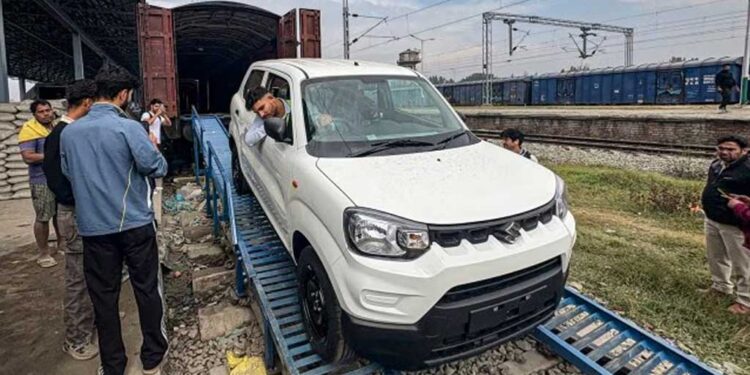Maruti Suzuki’s First Rail Delivery of 116 Vehicles to Kashmir Valley—a groundbreaking event that unfolded on October 3, 2025, when a dedicated freight train arrived at Anantnag Goods Shed, carrying pristine automobiles directly from the company’s Manesar plant. This pioneering initiative, leveraging India’s newest rail infrastructure, not only marks the debut of rail-based auto logistics to the region but also signifies a leap forward in connectivity, efficiency, and economic integration for Jammu & Kashmir.
In a landmark moment for India’s logistics, a special freight train rolled into Kashmir Valley on October 3, 2025, unloading 116 shiny new Maruti Suzuki cars—the first-ever auto shipment by rail to the region. This feat, buzzing across social media with videos of jubilant crowds and the train’s grand arrival, slashes old-school road hassles and paves the way for faster, greener mobility in the Himalayas.
The Route That Rewrites History
The journey highlights the engineering prowess of India’s rail network, transforming access to one of the world’s most challenging terrains:
- Departure Details: The train left Maruti Suzuki’s Manesar plant in Haryana on October 1, 2025, at 12:35 PM from the company’s newly inaugurated in-plant railway siding.
- Distance and Route: Covering 850 km over two days, it utilized the fully operational Udhampur-Srinagar-Baramulla Rail Link (USBRL), a ₹35,000-crore project featuring 38 tunnels, over 900 bridges, and the iconic Chenab Bridge—the world’s highest railway arch at 359 meters.
- Arrival Ceremony: It reached Anantnag Goods Shed at 9:50 AM on October 3, where local dealers and officials welcomed it with a cake-cutting event, marking the end of the 273-km road trek from Jammu that often took weeks due to landslides and snowfall.
- Historical Significance: This is the first automobile freight train to Kashmir in 78 years of Indian independence, following recent successes like apple and cement shipments via the same corridor.
Cargo Fit for the Valley
The shipment was tailored to Kashmir’s diverse driving needs, arriving in pristine condition without the wear from prior road deliveries:
- Total Vehicles: Exactly 116 brand-new cars, making Maruti Suzuki the pioneering automaker to use rail for Valley dispatches.
- Model Breakdown: Included rugged Brezza SUVs for mountainous roads, efficient Dzire sedans for urban use, versatile WagonR hatchbacks for families, and compact S-Presso minis for city navigation.
- Dealer Insights: Irfan Ahmad Narwaroo, director of Jamkash Vehicleades (Kashmir’s largest Maruti dealer), noted that cars now arrive “brand-new” without 300 km of road mileage, ensuring better availability and lower costs for customers during peak seasons like winter.
- Unloading Process: Vehicles were secured in specialized auto-freight wagons and unloaded amid cheers, with social media clips showing the shiny lineup against the scenic Anantnag backdrop.
Game-Changer on Tracks
This initiative delivers multifaceted benefits, boosting efficiency and safety in a region long isolated by geography:
- Time and Cost Savings: Reduces delivery from weeks to just days, cutting logistics expenses and minimizing road damage from heavy convoys.
- Safety Enhancements: Eliminates the risky practice of drivers piloting new cars over treacherous highways, reducing accidents and environmental impact.
- Official Endorsements: Union Railway Minister Ashwini Vaishnaw described the Jammu-Srinagar line as a “game-changer for Jammu & Kashmir,” tweeting about the Manesar-to-Anantnag route following apple shipments. Maruti MD & CEO Hisashi Takeuchi praised the USBRL’s “seamless connectivity,” aligning with the company’s rail-focused logistics strategy.
- Social Media Buzz: Social Media erupted with viral videos from rail enthusiasts and locals, including drone shots of the Chenab crossing and posts hailing it as a “historical moment” with thousands of likes and shares.
Fast-Forward to the Future
As this rail era dawns, the implications extend far beyond autos, signaling broader economic uplift:
- Expansion Plans: Maruti eyes regular dispatches, with potential for other goods like perishables to follow, under the PM GatiShakti initiative.
- Regional Impact: Expected to spur auto sales, tourism, and trade in Kashmir, where reliable transport has been a bottleneck.
- Broader Legacy: The USBRL, envisioned since the 1980s, now connects the Valley to the mainland, fostering growth in a post-Article 370 landscape.
Spot a fresh Brezza zipping through Srinagar? That’s progress in motion. What’s next for Valley logistics—more EVs by rail? Share your take below!










